If you’re somewhat familiar with pet parrots, you’ve probably heard of the green-cheeked conure and the sun conure. But did you know there are many more conure parakeets out there that make amazing pets? All have their own slightly different personalities, so there’s a conure for everyone.
Let’s have a look at some of the common types of conures kept as pets, with photos to make identification easier!
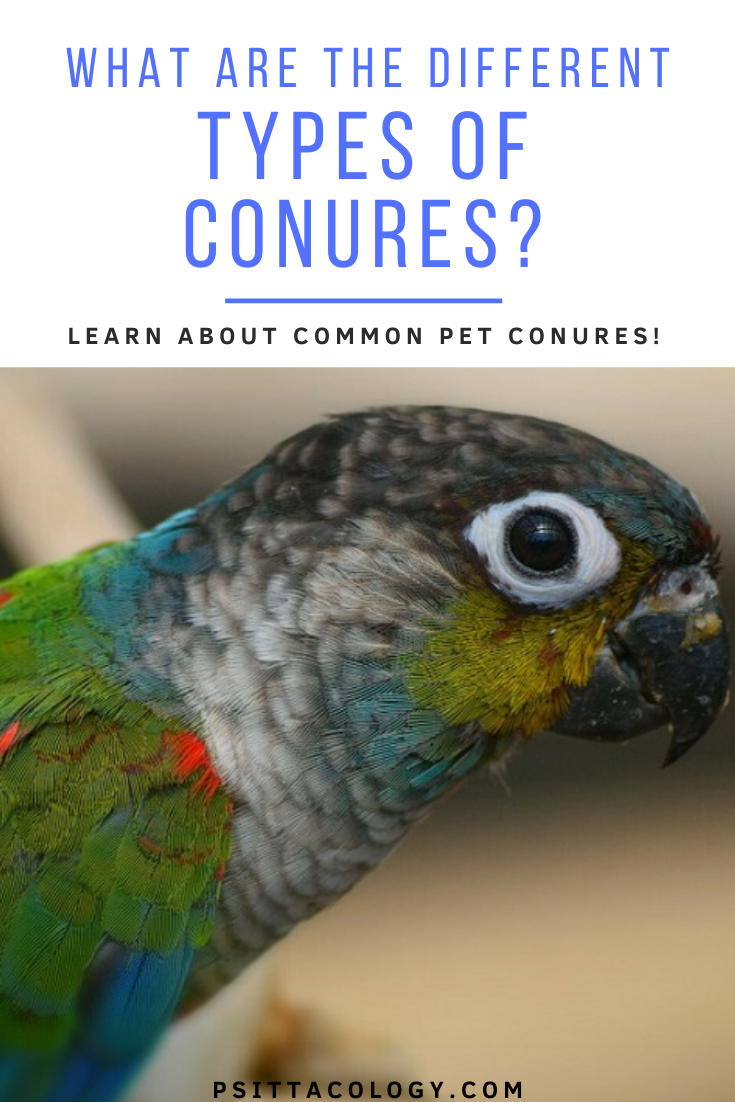
Types of conures: Genus Aratinga
Sun conure (Aratinga solstitialis)
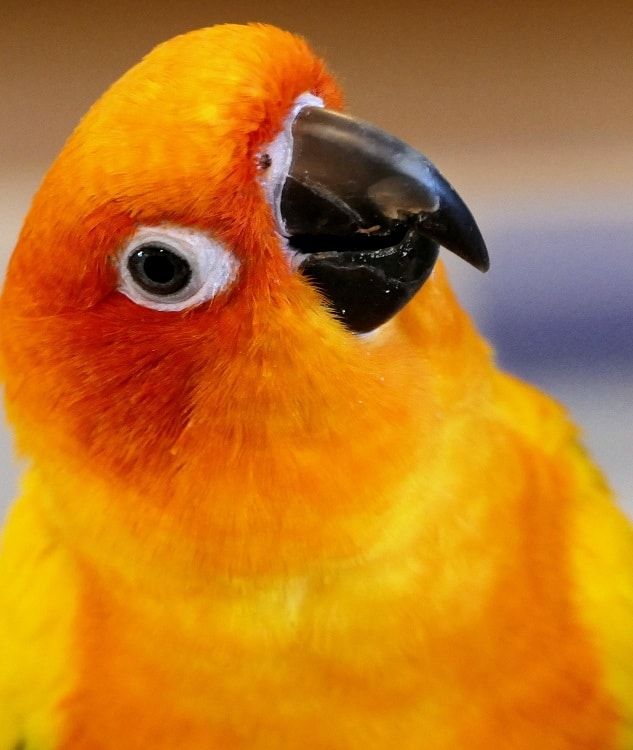
Among the most well-known types of conures is the sun conure, Aratinga solstitialis. These parakeets are easily recognized by their super bright yellow-orange coloration with green wings.
Naturally found in northeastern South America, sun conures inhabit forested areas where they can forage for fruits and nuts. They live in flocks and are highly social, forming monogamous pairs.
Sun conures and jenday conures (discussed below) are very similar in appearance if you’re not familiar with them. The trick is to look at the wings: sun conures have quite a bit of yellow on the outside of their wings while jendays don’t.
Sun conures are also extremely similar to the sulfur-breasted conure, Aratinga maculata, so much so that sightings of the two are sometimes confused in the wild.
Want to know more about sun conures? Learn all about sun conure lifespan and sun conure talking.
Jenday conure (Aratinga jandaya)
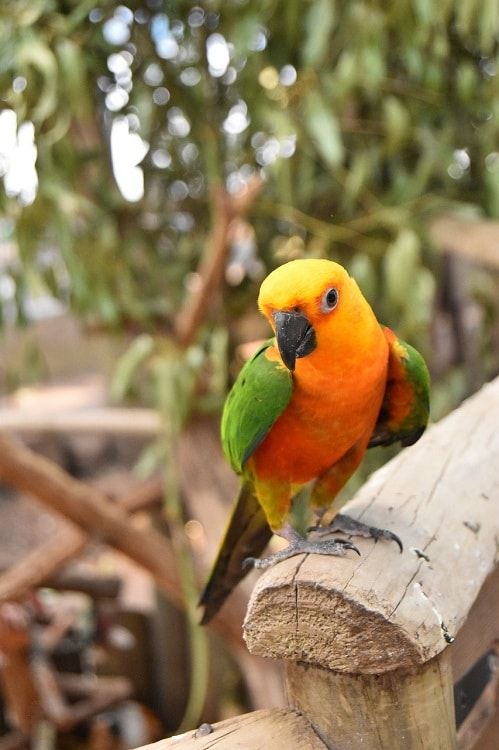
As mentioned above, jenday conures (Aratinga jandaya) are very similar in appearance to sun conures, which can make for confusion since both species are naturally found in Brazil. That’s why I wrote a full article explaining the differences between sun conure vs jenday conure.
Jenday conures are naturally found in forested areas in eastern Brazil. They feed on fruit and nuts, although like many other parrots they’re also sometimes considered pests by farmers, since they have a taste for human-grown crops.
If you’ve got time to dedicate to your parrot, jendays and other conures make great pets. They’re very smart and can be an incredibly fun addition to your family.
Nanday conure (Aratinga nenday)
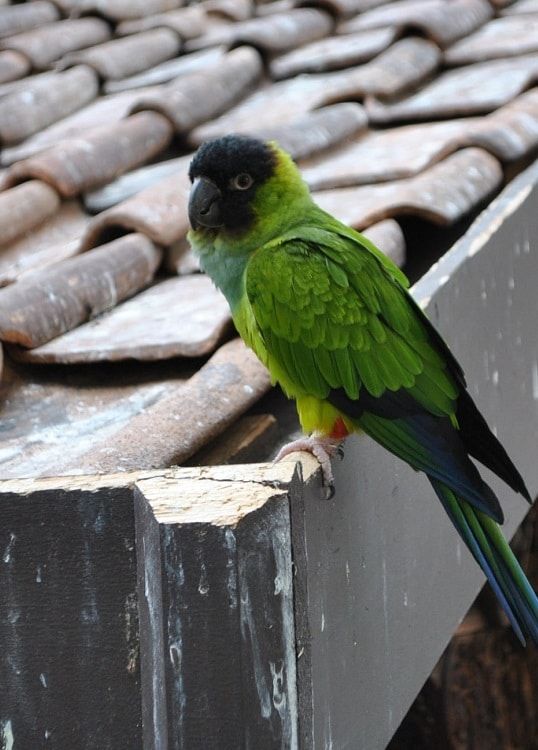
The nanday conure (Aratinga nenday) is very easy to recognize, as its black face contrasts pretty sharply against its green body. This species is also referred to as the black-hooded parakeet and it’s not difficult to understand why! A healthy nanday is quite a sight to see.
Nanday conures naturally have a pretty wide range in the heart of South America (Bolivia, Southwestern Brazil, Paraguay and northern Argentina). This region is referred to as Pantanal. Unlike the sun- and jenday conure they’re often found in relatively open areas, although they do also inhabit palm groves and will nest in hollow trees.
If you don’t mind a bit of noise and spending plenty of time socializing your bird, nandays can make lovely pets. They’re active and love bathing, being trained and having access to plenty of toys to chew up.
Tip: Nanday conures are sometimes still categorized under their former name, Nandayus nenday, but they are actually closely related to the other members of the Aratinga genus and classified as such.
Dusky-headed conure (Aratinga weddellii)
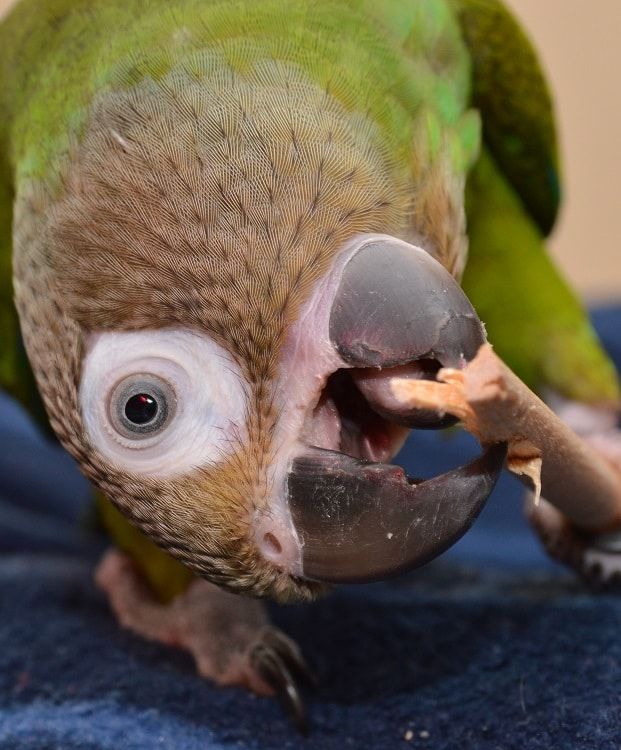
Dusky-headed conures (scientifically known as Aratinga weddellii) are slightly smaller than most of their other Aratinga cousins at a maximum weight of around 100 grams. They’re lovely colored conures with a green body, blue wing-tips and their signature greyish brown head.
Dusky-headed conures naturally occur in the South American Amazon basin, which stretches across a range of countries. They’re often found around forest edges near a water source and are known for their habit of nibbling on clay soil for the mineral nutrients it contains. They often nest in trees hollowed out by termites and their flocks can be very large.
As pets, dusky-headed conures are often seen as a great choice for those who find the popular green cheeks and sun conures a bit too much in terms of noise and activity level. They’re calm and respond very well to socialization training.
Gold-capped conure (Aratinga auricapillus)
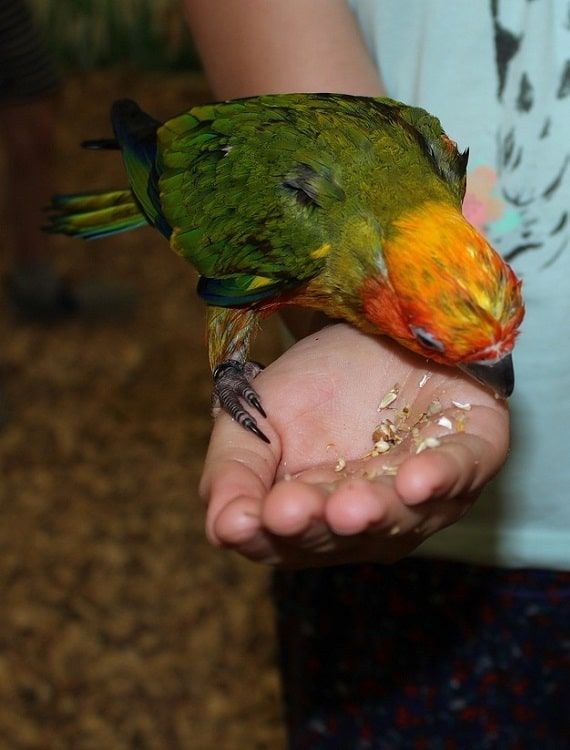
The gold-capped conure or flame-headed conure (Aratinga auricapillus) has the head of a sun conure but sports green feathers on its body. It’s naturally found in Brazil and Paraguay although its current status in the wild is unfortunately listed as “Near Threatened”, as the forest and savanna habitats the species inhabits are shrinking.
Although like many conures they can be a little nippy, gold-capped conures can make great pets if socialized properly. They can get pretty loud at times but accepting screeches and screams is really just part of being a parrot owner!
Like other conures, this species is playful and active. It needs a roomy cage, plenty of out-of-cage time and stimulation in the form of toys and objects to chew. Many gold-capped conures do also love a cuddle, though.
Did you know? The genus Aratinga contains one additional living conure species, Aratinga maculata (sulphur-breasted conure). Fossils of an extinct relative, Aratinga vorohuensis, also exist.
Types of conures: Genus Pyrrhura
Green-cheeked conure (Pyrrhura molinae)
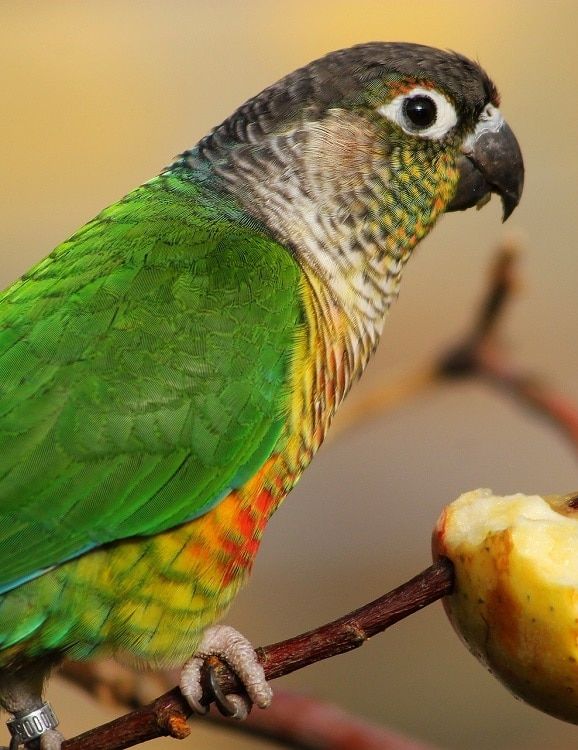
Meet the most common conure kept in captivity: the green-cheeked conure, Pyrrhura molinae. This one can be a bit difficult to recognize if you’re not familiar with types of conures, because although wild birds all sport the same look, selective breeding has made for a whole lot of man-made green-cheeked conure varieties.
Wild-type green-cheeked conures have a dark brown head cap, green cheeks (bet ya didn’t see that one coming!), a greyish collar, green wings and a dark red lower belly and tail area. Domestic varieties range from a light tan to mainly red or even blue. They might lack the head cap and some don’t even have the typical green cheeks!
Green-cheeked conures are naturally found in forested areas in the heart of South America, where flocks live in the treetops. In captivity, they’re appreciated for their quiet nature, which is a far cry from the classic screeching of most of the Aratinga genus we discussed above.
Pet green cheek conures are appreciated for their huge personalities: they’re often referred to as the clowns of the parrot world. Many like to be held and cuddled and some can even learn to speak a few words.
Playtime is very important for these conures. Although an overly excited green cheek can be prone to nipping, proper socialization can prevent this behavior.
Tip: Did you know that green cheeked conures have an amazing lifespan? They can live for up to 30 years in lucky cases! More about their lifespan and what influences it can be found in the article on green cheek conure lifespan.
Crimson-bellied conure (Pyrrhura perlata)
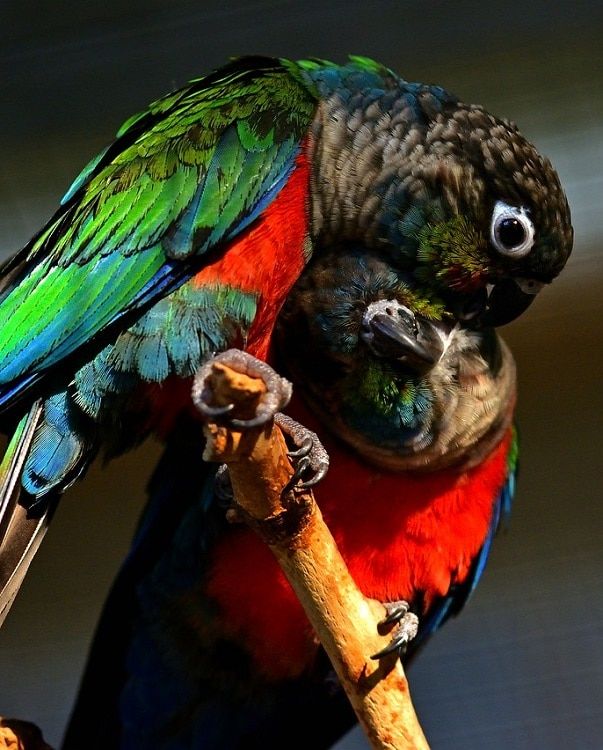
When it comes to spectacular colors it’s hard to beat the crimson-bellied conure, Pyrrhura perlata. This gorgeous conure is naturally found in the Amazon rainforest in Brazil and Bolivia, although unfortunately its natural habitat is rapidly disappearing and the species is classified as Vulnerable.
Although they can be a bit difficult to find, crimson-bellied conures make lovely pets. Like the previously mentioned green-cheeked conure they’re relatively quiet: they do more soft chirping than screaming flock calls. They are very active but most of them also love a good cuddle.
If you understand Latin at all, the scientific name for the crimson bellied conure is a little confusing. Perlata means pearly and we’re discussing the pearly conure in a bit, so why was the name ‘pearly’ not used for that species?
Well, as it turns out, the bird they used as the example of a pearly conure (the type specimen) was actually a young crimson bellied conure, so in the end that caused the reclassification of the crimson bellied conure to the name ‘pearly’. Scientific oopsie!
Maroon-bellied conure (Pyrrhura frontalis)
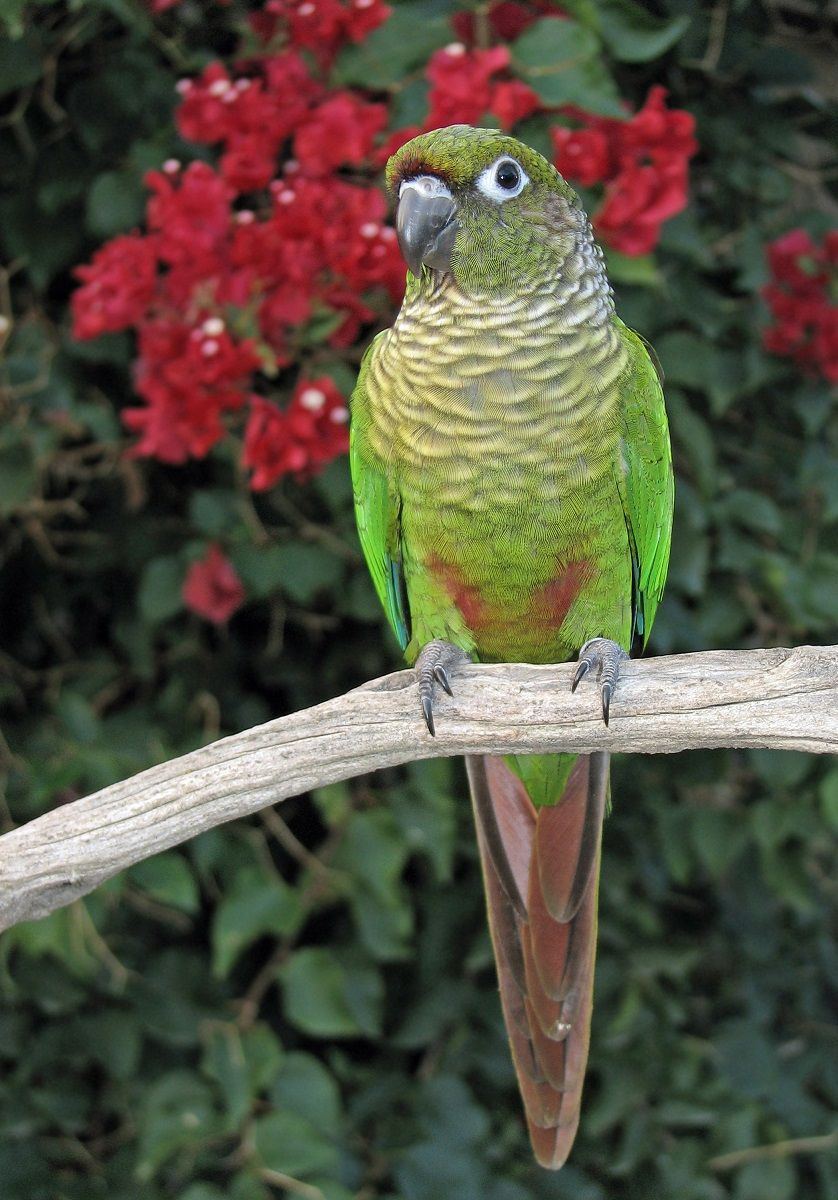
Yes, there are both a maroon-bellied conure and a crimson-bellied conure (see above), and they’re not the same bird! In terms of color, the aforementioned crimson bellies are winners, while maroon bellies are very similar to the ultra-popular green cheek conure.
The maroon-bellied conure is naturally found in forested regions from southern Brazil to northern Argentina. As pets, they’re appreciated for their social nature and friendly disposition. They need good socialization like all conures, but they’re not overly prone to behavioral issues.
Although maroon bellies are considered quiet as far as conures go (much quieter than any of the Aratingas!), don’t forget that when they do decide to make noise, their calls are still pretty ear-piercing.
Black-capped conure (Pyrrhura rupicola)
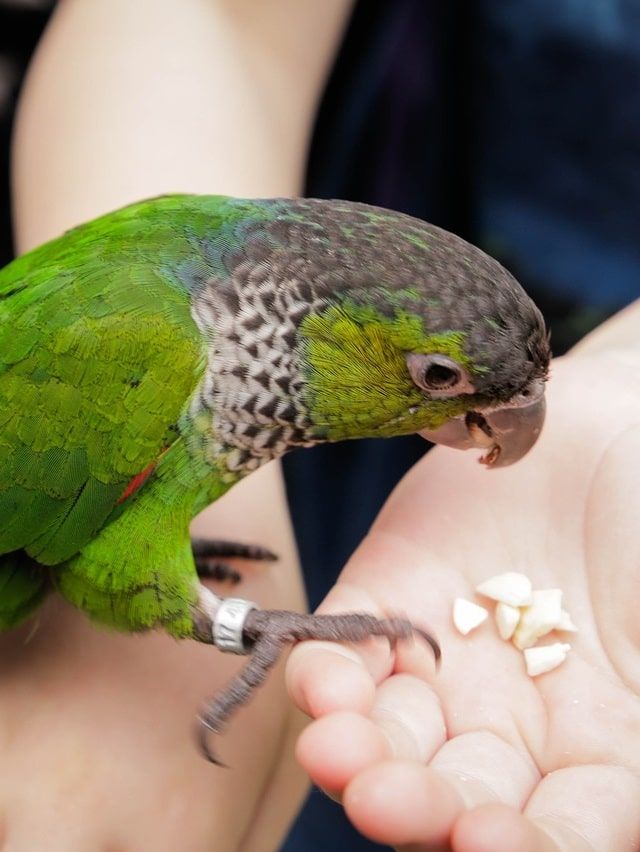
Don’t confuse this one with the black-hooded conure, which is a common name for the previously mentioned nanday conure! The black-capped conure can easily be told apart from this species by its beautiful gray scalloped “necklace” of pearly feathers.
The black-capped conure can naturally be found in both the lowland forests of the southern Amazon basin as well as higher altitude areas on the eastern side of the Andes mountains. Like a number of the other species on this list, the natural population is threatened by habitat loss. This has led to black-capped conures being listed as Near Endangered.
Although they don’t sport the spectacular colors of a crimson-bellied conure and aren’t available in a wide range of mutations like green cheeks, you shouldn’t overlook black-capped conures if you’re looking for a pet bird. As long as they receive enough attention they’re pretty quiet and most of them love scritches and cuddles.
Your pet black capped conure will quickly become bored if you don’t offer enough stimulation so you should always ensure it has plenty of fresh toys to entertain itself with.
Pearly conure (Pyrrhura lepida)
Like many other types of conures of the Pyrrhura genus, the pearly conure (Pyrrhura lepida) is naturally found in the Amazon rainforest of Brazil. And as with other Brazilian species, it’s unfortunately in danger of losing its natural habitat, since the country’s logging laws are still pretty lax. It’s considered Vulnerable by the IUCN Red List of threatened species.
This species looks very similar to the crimson bellied conure we discussed earlier, with one big difference: it lacks that typical red belly. Still, scientific research indicates that the two appear to be closely related.
Like other conures, the pearly conure makes the perfect pet for someone looking for a ‘partner in crime’. They are active, clownish and sometimes mischievous, maybe a bit too smart for their own good. That is if you can find one; they’re unfortunately not all that common in the pet trade.
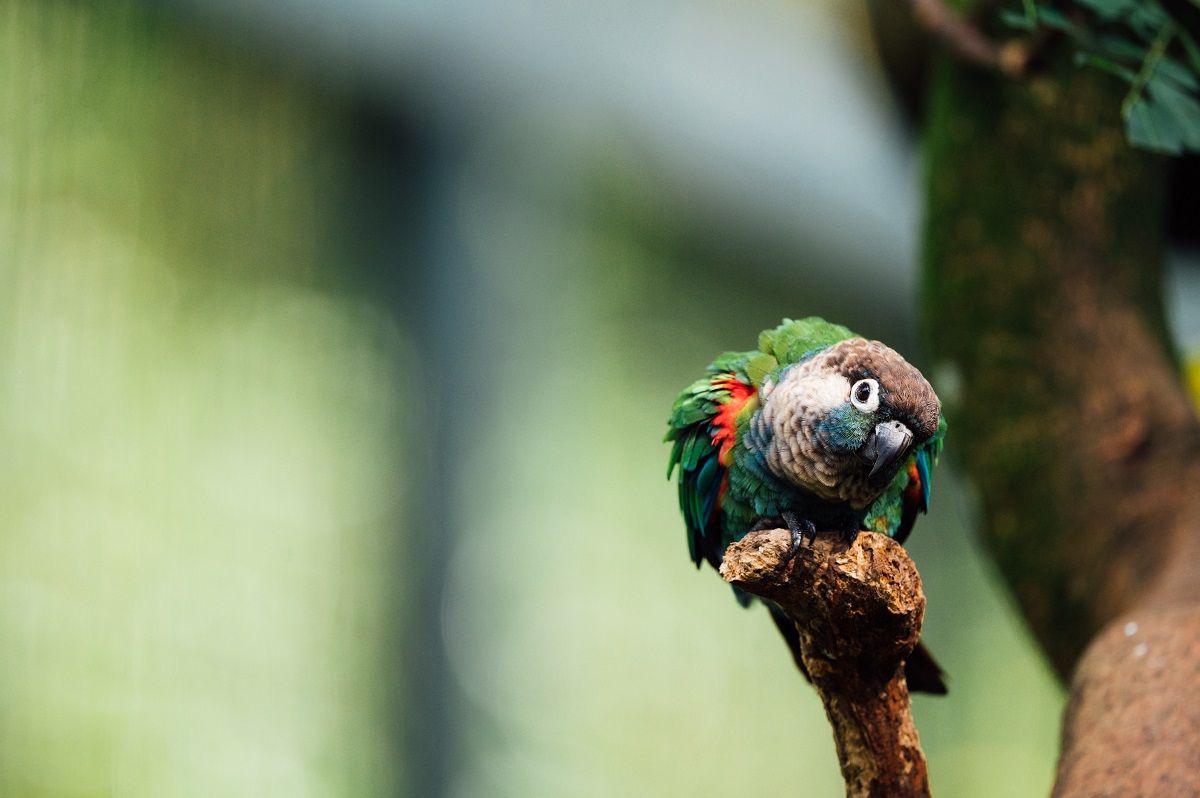
Pearly Conure Parrot Profile | A Bejeweled Beauty
The South American genus Pyrrhura contains various beautiful parakeets, also known as conures. The green cheek conure is the most well-known, but there’s more! Today, let’s have a look at …
Read moreBlue throated conure (Pyrrhura cruentata)
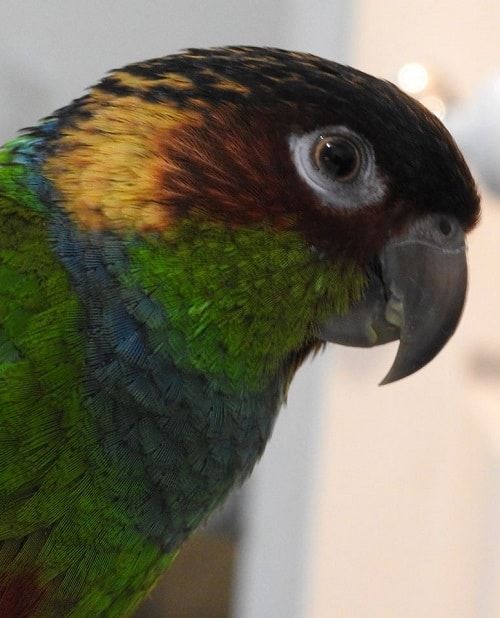
Also known as the ochre-marked conure, the blue-throated conure (Pyrrhura cruentata) is a beautifully colored parrot that can naturally only be found in Brazil.
Despite having been named after its blue neck area, the most striking feature of the blue-throated conure might actually be its dark red belly. Unlike with crimson-bellied conures, this is not a bright red but more of a red wine color.
In the wild, blue-throated conures can be found in humid rainforest habitats. Unfortunately, like some of the other parrots on this list, the species is under threat from their natural foraging and nesting grounds being turned into agricultural land. This leads to the disappearance of trees and has resulted in a IUCN Red List status of Vulnerable.
Blue-throated conures are not among the most common conures in the pet trade but those who manage to find one can count themselves lucky. They’re not too loud as far as conures go and have that typical conure intelligence level that both gets them in trouble and makes them so much fun. They love having lots of toys and frequent access to a dish to bathe in.
Painted conure (Pyrrhura picta)
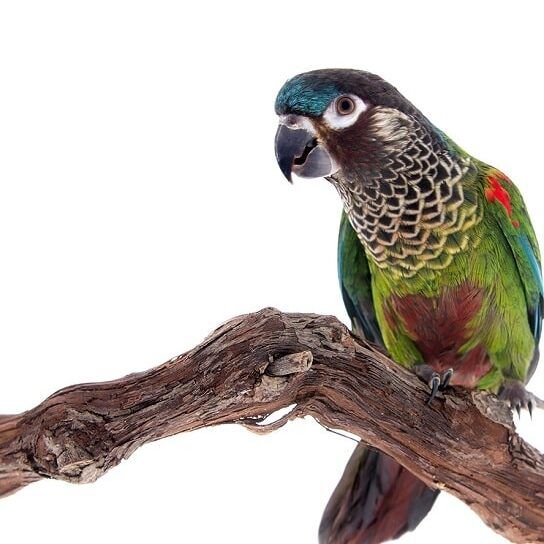
The absolutely spectacular painted conure (Pyrrhura picta) is a combination of all the colors and patterns a conure can have. It sports pearly neck feathers, a blueish hat, green chest and wine red belly. Truly a beautiful bird to behold!
Naturally found in forests in the northern areas of South America, this species is a bit of a taxonomic mess. It was first thought to include a few others that are now classified as separate species in the Pyrrhura genus and there are also a few subspecies, which is confusing. The subspecies can have slightly differing colors and patterns.
Whatever subspecies of painted conure you’re looking for, all of them are relatively expensive and difficult to find. If you do manage to obtain one, congratulations, they make lovely pets. They’re considered quite laid back as far as conures go and are generally very sweet.
That being said, they’re still inquisitive and active like typical conures so they need plenty of attention and stimulation!
Tip: We’ve discussed seven species from the Pyrrhura genus here that are relatively commonly types of conures to be kept as pets. The genus has way more members, though, and also contains a bunch of subspecies.
Types of conures: Genus Eupsittula
Peach-fronted conure (Eupsittula aurea)

The peach-fronted conure (Eupsittula aurea) is a pretty, relatively small species with a large range in the middle and eastern countries of South America. Here, it inhabits relatively open habitats like savanna, although it also makes good use of the presence of humans by frequenting their farmlands.
As long as you can supply a roomy cage, plenty of out-of-cage time and lots of attention, the peach-fronted conure is a great option for those looking for a pet parrot. They’re in the moderate area as far as conure loudness goes and they’re guaranteed to be the life of any party with their lively personalities.
You probably won’t have much trouble training your peach-fronted conure and it might even learn to say a few words! Do keep in mind that lots of stimulation really is crucial for these birds and they might turn to plucking their feathers and loud screaming if they’re bored.
Half-moon conure (Eupsittula canicularis)
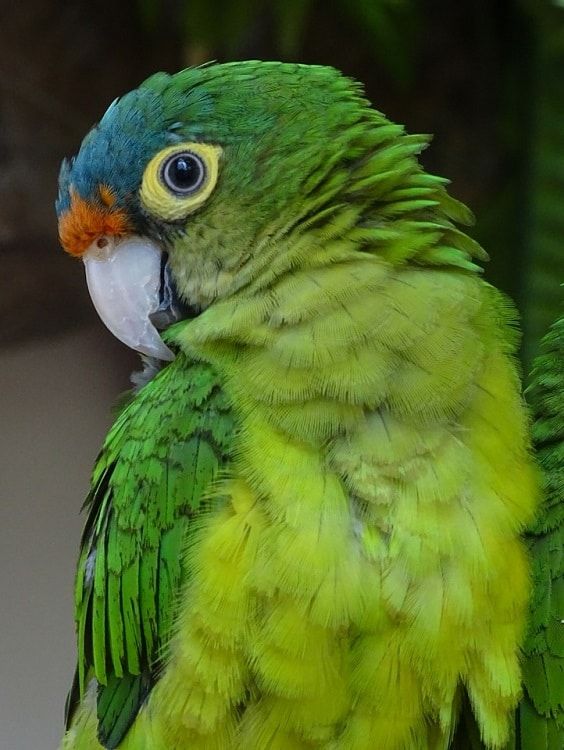
Half-moon conures (Eupsittula canicularis) are also commonly referred to as orange-fronted conures. They are naturally found in Mexico and Central America down to Costa Rica, where they inhabit half-open habitats like forest edges and savannahs. They feed on a variety of fruits, seeds and flowers and they can form large flocks.
Like dusky-headed conures, half-moon conures tend to nest in termite nests in trees. At a maximum weight of only around 80 grams, they are relatively small.
Like other conures, the half-moon conure is much appreciated by parrot enthusiasts as a pet. The species is not too loud; aside from normal flock calls they will usually do more chattering than screaming. As always, you’ll have to provide your orange-fronted conure with plenty of attention, toys and out-of-cage time to keep it happy and healthy.
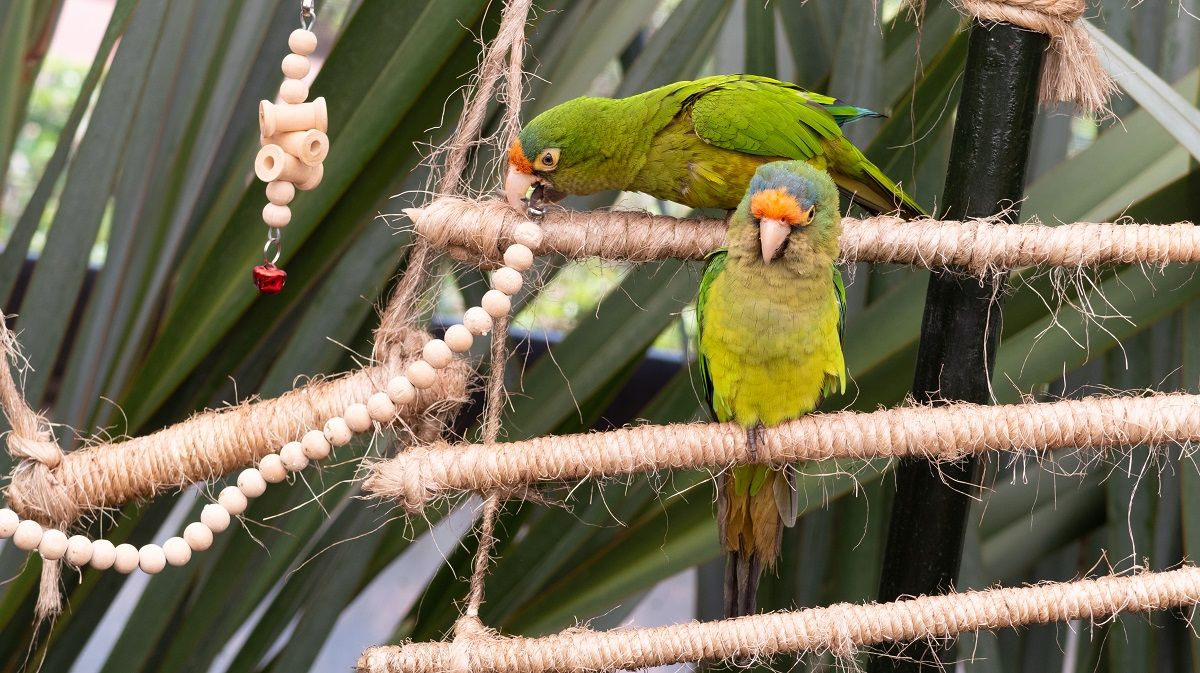
Half-Moon Conure Parrot Profile | (Orange-Fronted Conure)
The half-moon conure is a boisterous South American parrot popular as a household pet. They’re known for being friendly and easy to train, but they’ve also got big attitudes! Also …
Read moreTip: The genus Eupsittula contains three more, less commonly kept conures. They are Eupsittula nana (olive-throated conure), E. pertinax (brown-throated conure) and E. cactorum (Caatinga conure).
Types of conures: Genus Psittacara
Cherry-headed conure (Psittacara erythrogenys)
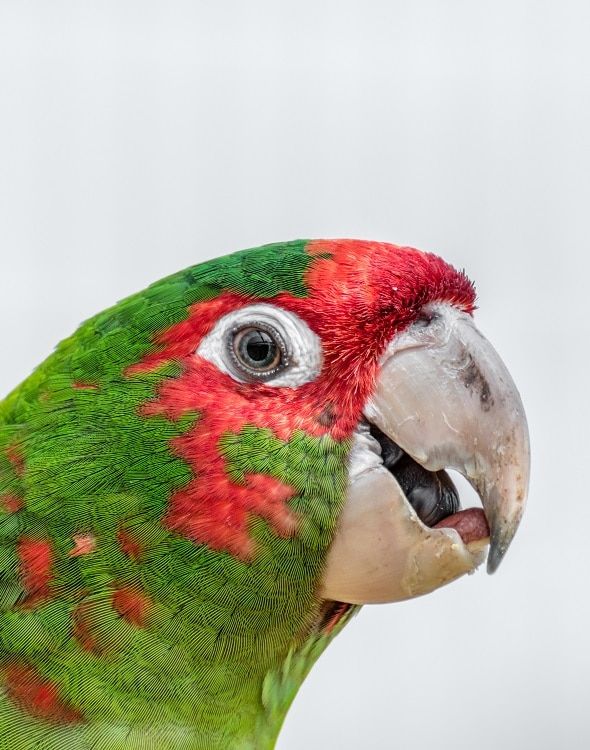
It’s not difficult to spot a cherry-headed conure (Psittacara erythrogenys, also known as red-masked conure or red-headed conure): the combination of a green body with a bright red face and red splotches trailing down from the head area is hard to miss.
Cherry-headed conures naturally occur in Perú and Ecuador. Here, they can be found in forested areas, although they’ve also made their home in areas more densely populated by humans.
Feral populations exist in various countries. This is not surprising: as far as South American parrots go, they’re relatively popular in the pet trade. Escapes or releases are bound to happen.
Cherry-headed conures are known as one of the most talkative types of conures. They’re intelligent and generally easy to train, so you should be able to teach yours a few words or phrases.
With this talkative nature does come a certain degree of loudness, so you might have to pass on this one if your home has thin walls. Daily screaming fits are not unheard of in these parrots!
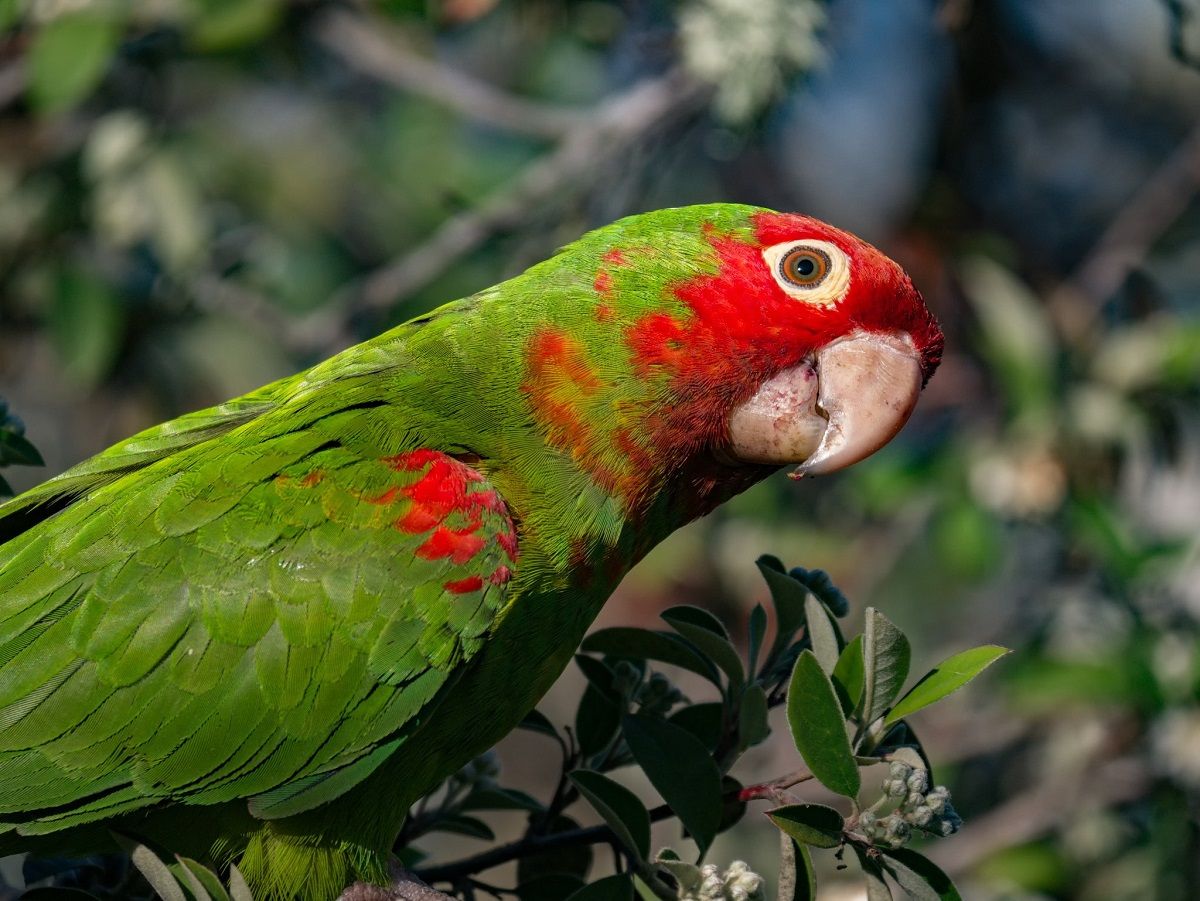
Cherry-Headed Conure Parrot Profile | (Red-Masked Conure)
Do you like talkative parrots? Is your life lacking in shenanigans? Then the cherry-headed conure might be just the pet for you! Also known as the red-masked conure or red-headed …
Read moreMitred conure (Psittacara mitratus)
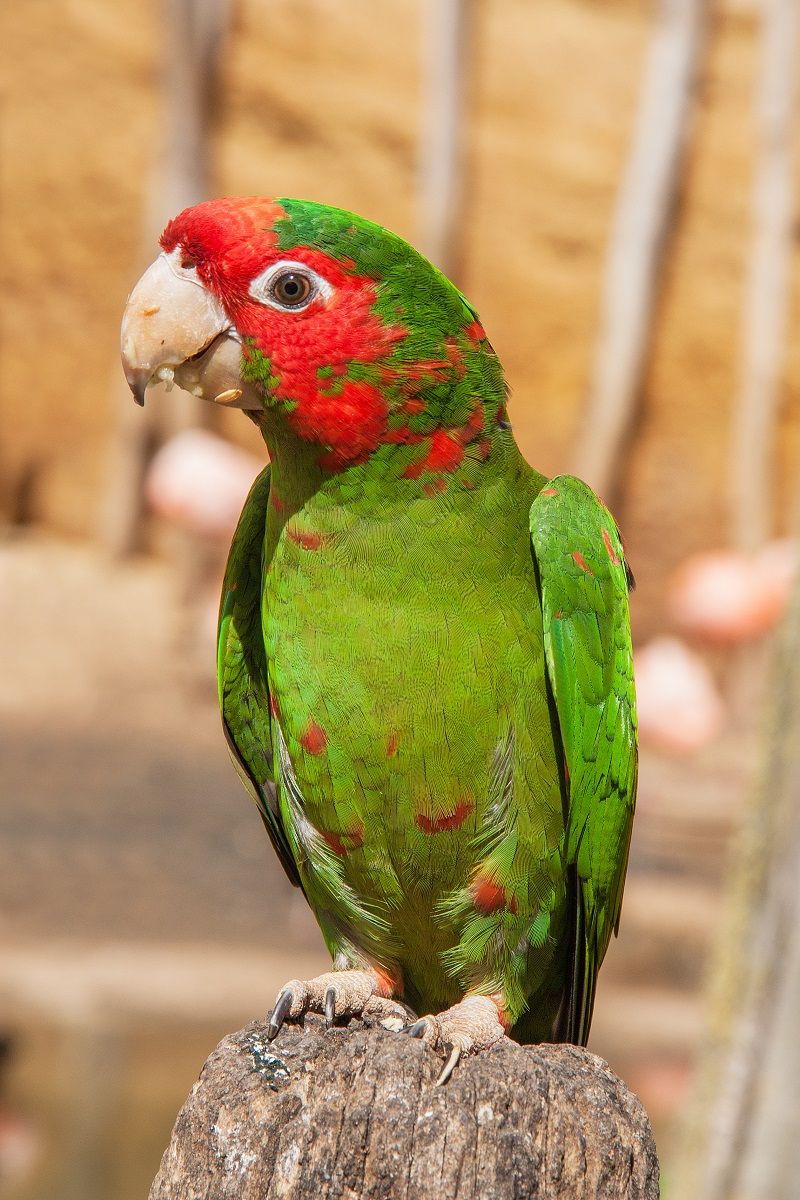
If you think you’re seeing double, that’s because mitred conures (Psittacara mitratus) do look pretty similar to the aforementioned red masked conure when it comes to their color and pattern.
The size of the red face patch can vary in both species, making it difficult to distinguish between the two (as well as a few of the other Psittacara species, like the scarlet-fronted conure discussed below).
To add to the confusion, the genus Psittacara wasn’t even really a thing until recently, so you might still see the mitred conure referred to by its former name, Aratinga mitratus.
Mitred conures naturally inhabit Andean forests, from Perú all the way down to Argentina. There are also feral populations present in a bunch of countries, including in California and on the Hawaiian island of Maui.
Like the other members of Psittacara discussed here, these are relatively popular pets. They’re social, loving and fun, but keep in mind they can be very loud.
Scarlet-fronted conure (Psittacara wagleri)
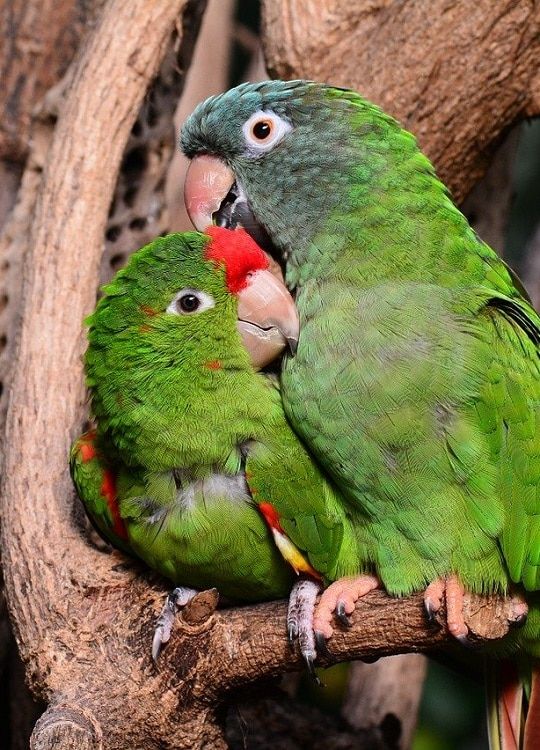
What a surprise: another green-bodied and red-headed conure! This one’s called the scarlet-fronted conure and is naturally found in the northwestern tip of the South American continent (Venezuela, Colombia, Ecuador and Perú). It inhabits forested areas that can be at relatively high altitudes.
The difference with other members of Psittacara is in the size (the scarlet-fronted conure is one of the largest conures overall) as well as the size of the red head patch. This colored area is usually (though not always) smaller than in red-masked conures, for example.
Like all conures this is a very social parrot by nature, making it a great pet and a friend for life as long as you have plenty of time to invest in your bird.
Tip: The genus Psittacara contains a bunch of additional types of conures that we can’t all discuss here. The genus as a whole is recognizable by its members’ green body color, usually with red accents that are generally (though not always) on the head.
Types of conures: Other genera
Blue-crowned conure (Thectocercus acuticaudatus)
The blue-crowned conure (Thectocercus acuticaudatus) can be found in both open habitats and more forested areas in its very wide natural range in South America. This species occurs as far north as Colombia and as far south as northern Argentina!
Blue-crowned conures are relatively popular and they do make lovely pets with their typical conure intelligence and activity levels. They are usually very open to learning new things and will establish a strong bond with their owner. Their clownish personalities are extremely endearing and although they can be mischievous as well, it’s hard to stay mad at them.
Blue crowns are pretty good talkers as far as conures go, although unfortunately their voices are pretty raspy, which can make it rather difficult to understand what they’re actually trying to say. As with the previously mentioned red masked conure, this talkative nature does also mean that they can get up to at least a moderate noise level.
Golden conure (Guaruba guarouba)
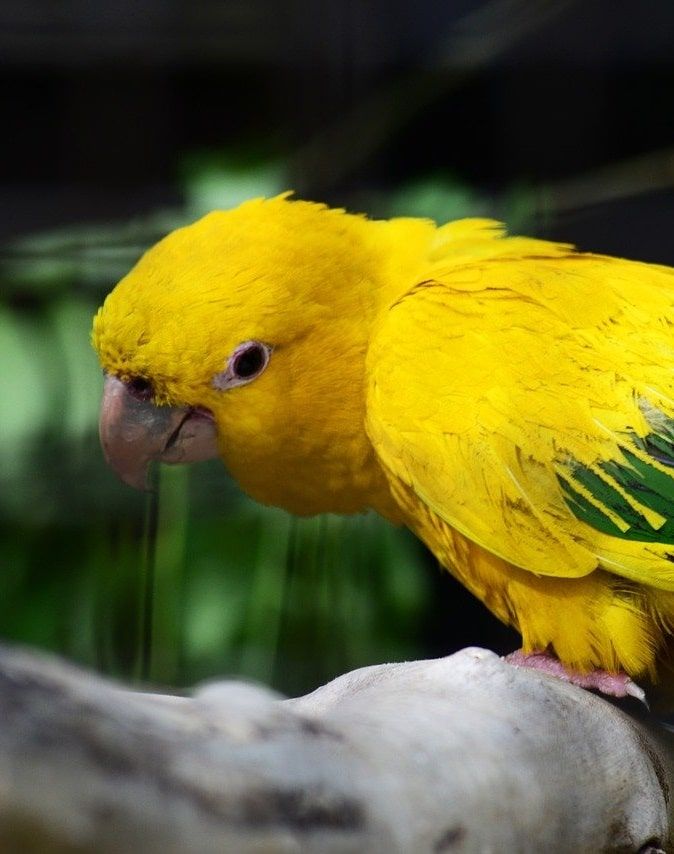
Golden conures (Guaruba guarouba) are very closely related to the jenday conure, which was discussed in the section on Aratinga conures. In fact, golden conures used to be classified as members of the Aratinga genus as well, although they are now the only species in the genus Guaruba. They’re also sometimes referred to as Queen of Bavaria conures and are among the largest of their kind at around 270 grams.
Wild golden conures have always had a relatively limited range, only occuring in Northern Brazil. Unfortunately their natural habitat has only shrunk in recent years, leaving them gone from areas that they formerly inhabited and causing the species to be listed as Vulnerable on the IUCN Red List.
The fact that locals sometimes consider them pests and extensive hunting for the pet trade certainly hasn’t helped golden conures. It’s easy to imagine why they became popular as pets, though: their almost neon yellow coloration with strongly contrasting patches of green is spectacular to say the least.
Golden conures have more to offer their owners than just their beautiful appearance: they make great companions. Although they need a lot of attention to prevent screaming fits and feather plucking, they’re also usually very cuddly and extremely curious and intelligent.
Fact: Golden conures are nomads that can usually be found in tall dryland forests for much of the year but move to more open areas when it’s time for them to breed.
Patagonian conure (Cyanoliseus patagonus)
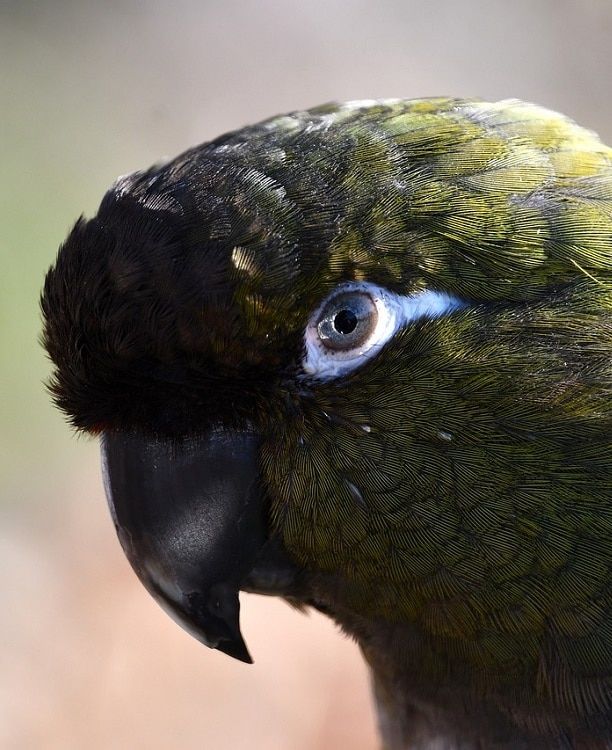
Now this is a pretty special conure! The Patagonian conure (Cyanoliseus patagonus) is naturally found in Argentina and occasionally Chile and Uruguay, where it inhabits a variety of habitats.
Some of these areas can be harsh and unwelcoming, like the arid steppe areas in the Monte Desert which make up their main living space. Here, the Patagonian conure lives in flocks, although males and females pair off and stay monogamous.
At one point things were going quite badly for this species, with capture for the pet trade and their status as agricultural pests causing a lot of trouble for them, although luckily their situation has improved since then.
The Pagatonian conure is the only member of its genus, Cyanoliseus. It’s unusual in that it’s the largest conure, with a maximum weight of a whopping 280 grams even in the lesser subspecies (Cyanoliseus patagonus patagonus). Greater Patagonian conures (Cyanoliseus patagonus byroni) can weigh up to a 100 grams more than that, though you generally won’t see these in the trade.
Patagonian conures make absolutely lovely pets, even if you consider their rather harsh voices and tendency to be somewhat noisy. They’re very good at imitating sounds and generally appreciate a cuddle. Things really can’t get boring with a “Pattie”, as they’re just the perfect combination of friendly and fun.
Fact: Since their open habitats don’t feature much in the way of suitable nesting spots, Patagonian conures often nest in burrows. That’s why they’re also referred to as the burrowing conure.
If you have any more questions about the different types of conures discussed on this list, or if you want to share your own experiences with these birds, don’t hesitate to leave a comment below!
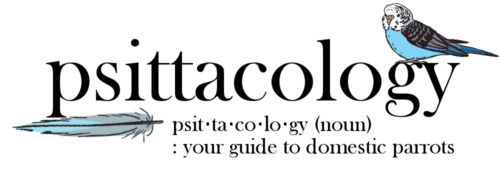
You didn’t talk about the brown throated conure. I have one and he’s really sweet and smart, though can get loud when alone. No one ever mentions these guys!
Wish I could discuss all of them but this article would turn monstrous, haha! There are so many. Thanks for sharing though, they seem really cool 🙂
The Conures shown here are all misslabled. What a joke
Feel free to let me know which ones are incorrect according to you!
I think he’s looking at a picture and reading the article below instead of above.
I’ve looked up further pictures of a bunch of them, and I can’t see any that appear wrong. There certainly seems to be some variety in some of them (not all birds of a type have identical colouring/patterns) but none of them appear mislabelled.
To the author: thanks for the article, I really enjoyed it! 🙂
Yeah I’m not sure where that comment came from, I checked all the pics a billion times. I’m glad you enjoyed it! I should do all the conures, but then it’d be an entire ebook, haha.
My guess is that the person was misunderstanding which picture went with the description (thinking that the picture was on top of the description?) just a guess though.
Oooh. That makes sense! I hope they realized at some point.
I was hoping to send you a photo to find out what a certain conure is, but it won’t let me. Any way I can get a photo to you? It’s green with maybe a lighter stomach … hard to tell from the photo I have. Someone said she’s seen them in Brazil.
Thanking you ahead of time.
Leslie
Yes, you can send it to the Psittacology Facebook account through the chat function or you can email it straight to psittacology (at) gmail (dot) com. I’ll take a peek! I’m no absolute expert though, especially if the photo isn’t high quality. Could also consider joining a conure oriented FB group and ask there! 🙂
I have never heard of a Southwestern Conure, and I can’t find pictures on the internet. Think aratinga, slightly smaller than Nanday, but absolutely all green. Is there another name for this bird? Thanks!
Aratinga holochlora is the only one I can think of, usually just referred to as green parakeet. Is that what you’re thinking? I’ve never seen them referred to as Southwestern conure though. Or maybe a socorro parakeet from the Psittacara genus?
Ok I’m trying to figure out what type of conure my grandmother had so I can make her a gift (hers died a few years back and we all loved that bird)
But she had a blue top of the head and a red check area. If she lifted her head and neck feathers while scratching there was red underneath. And there was red and tiny bits of blue in her tail. Anyone have any suggestions? Is it possible she was some type of mix? Please help
Any pics? That would be very helpful. Maybe ask her if it’s not too obvious? You could send them to psittacology (@) gmail dot com and I’ll employ all the parrot ID methods I’ve learned while running this site, haha.
I once had a conure with a green head. Not black, not grey. I don’t see him here.
Hey! This list is not exhaustive, because when I wrote it, I figured no one wanted to sit there looking at dozens and dozens of birds. I think it might be time to expand it, though. Is it possible yours was a blue crown with a more greenish hue to the head? Or maybe a maroon belly, those also often have green heads. There are a few possibilities, but of course it’s hard to say without a pic.